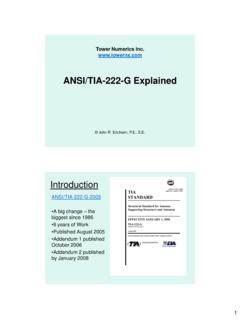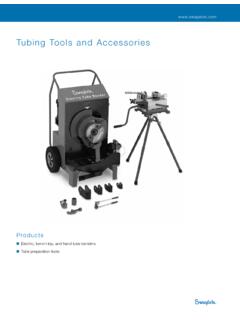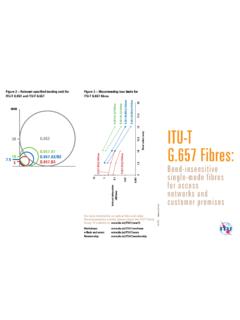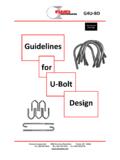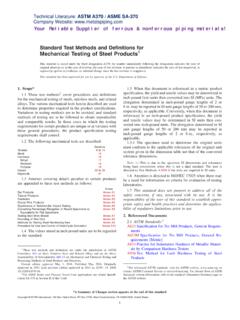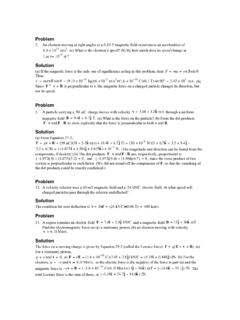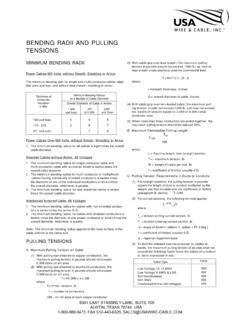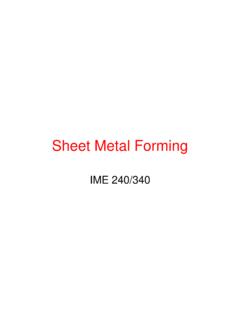Transcription of Manufacturing Workmanship Standards
1 Manufacturing Workmanship Standards YHF-WS Rev 2. Approved by & date: 02/25/16 Approved by & date: 02/25/16. York Haven Fabricators, Inc. Workmanship Standards This document is a statement to the quality and Workmanship of York Haven Fabricators, Inc., henceforth referred to as YHF. The definitions, procedures, and responsibilities contained in this Workmanship Standard are fully supported by: President Michael Shefet General Manager Richard Washko Senior Programmer Jim Sauble Production Manager Michael Goodling Material Review Board: General Manager Richard Washko Quality Manager Jon Sobkowiak Quality Technician Paul Nash Production Manager Michael Goodling ~2~. York Haven Fabricators, Inc. Workmanship Standards 1) Purpose The purpose of this specification is to define standard quality Workmanship requirements for sheet metal fabricated by YHF.
2 2) Scope The intent of this specification is to supplement all engineering drawings, blueprints, and customer specifications. If a conflict exists between this specification and the requirements outlined in the engineering documents or customer specifications, engineering documents and customer specifications shall take precedence. This Workmanship standard shall be invoked when aforementioned documents do not clearly define requirements. 3) Responsibility It shall be the responsibility of all YHF personnel to conform to requirements called out in this Workmanship standard. 4) General Sheet Metal Requirements A) The tolerances in this specification shall not override those provided on engineering documents, blueprints, and specifications. In all cases, blueprint tolerance or work order instructions shall override this standard. B) All blueprint dimensions will be interpreted as prior to organic finish unless specified otherwise.
3 C) When grain direction is not specified, raw material will be nested to maximize usage. D) Variation from flatness shall not exceed per inch of material. E) Angles not specified on engineering documents which appear to be 90 will be interpreted as 90 . Angular tolerances will be interpreted as +/- 1 if not specified on the documents. F) Nibble marks as a result of multiple punching sequences are not considered a burr. Nibble marks are acceptable and will be minimized whenever practical. ~3~. York Haven Fabricators, Inc. Workmanship Standards G) Mismatches or steps on a punched edge or cutout may not exceed . H) When bend radii are not specifically called out on the blueprint or specification, a sharp radius shall be manufactured. I) Radii on ground surfaces shall be blended smoothly, consistent with the external surface radii. No flat areas are acceptable.
4 J) Large bend radii will cause grain to stretch and distort or smooth out. This is to be expected and considered acceptable. K) Weld spatter is not desired and shall not appear on cosmetic surfaces. Minor weld spatter is acceptable on non-cosmetic surfaces. All hardware, thru holes, and threads must be free of weld spatter. L) All features which are dimensioned from a formed edge shall be measured at the bend line. Angular, squareness and flatness call-outs will govern the remainder of the profile. M) Hardware shall be installed per manufacturer's specification. When drawing requirements conflict with manufacturer's specifications, YHF shall not be responsible for resulting limitations. N) Slight imperfections in diameter and edges related to the start of a laser cut or Lead-In are typical in laser operations and not considered a defect.
5 ~4~. York Haven Fabricators, Inc. Workmanship Standards 5) General Dimensions and Tolerances A) The following chart depicts general Manufacturing tolerances, which can be accomplished with standard Manufacturing techniques. Stud or standoff locations shall be taken from the base of the hardware. Specifications which require closer tolerances than those listed below will typically require special processing or fixturing to obtain compliance. Dimensioned Tolerances Tolerance Hole to Hole +/- . Hole to Edge +/- . Edge to Edge +/- . Hardware to Hole +/- . Hardware to Edge +/- . Hardware to Hardware +/- . Hole to bend +/- . bend to Hardware +/- . bend to bend +/- . bend to Edge +/- . B) The following chart indicates standard hole diameter tolerances which are to be held during fabrication at YHF. The tolerance for any size diameter requiring hardware is +.
6 003 . Hole Diameter Tolerance Less than + . to + . to + . to + . to Above + . C) Shapes other than circular are defined as cutouts. Unless otherwise specified, the tolerance for cutouts shall be +/- . ~5~. York Haven Fabricators, Inc. Workmanship Standards D) Countersink diameters have standard tolerances independent of the above listed standard diameter tolerances. These tolerances are listed as follows: Countersink Dimension Standard Tolerance Less than + . to + . and Above + . E) Sheet metal will be purchased with a nominal requirement. Nominal dimensions will have a tolerance as listed below. Material thickness shall be measured no less than from any coil width edge. Ref. Cold Rolled Hot Rolled Stainless Steel Galvanized Aluminum Gauge Steel Pickle & Oil 26 - - - - - - - - .016 + 24 .024 + - - .023 + .028 + .020 + 22 .030 +.
7 030 + .034 + - - 20 .036 + - - .036 + .040 + .032 + 18 .048 + - - .048 + .052 + .040 + 16 .060 + .060 + .060 + .064 + .050 + 14 .075 + .075 + .075 + .079 + .063 + 13 .090 + .090 + .090 + .094 + - - 12 .105 + .105 + .105 + .108 + .080 + 11 .120 + .120 + .120 + .124 + .090 + 10 .135 + .135 + .135 + .138 + .125 + 7 - - .180 + .180 + - - - - .187 - - .187 + .187 + - - .190 + .250 - - .250 + .250 + - - .250 + .3125 - - .3125 + .3125 + - - - - .375 - - .375 + .375 + - - .375 + .500" - - .500 + .500 + - - - - F) When tolerances are not specifically called out on blueprints, YHF will manufacture sheet metal products to the following tolerances..XXX +/- ..XX +/- ..X +/- . Fractions +/- 1/16 . ~6~. York Haven Fabricators, Inc. Workmanship Standards 6) Sharp Edge and Burr Standards A) Unfinished End Product I) Unfinished material being punched or laser-cut will be dressed at the blanking operation to remove laser slag or burrs.
8 A burr is defined as raised or displaced metal. II) When a specific callout for safe handling edges are identified on the drawing, specified edges must pass the requirements of UL 1439. sharpness specification. Safe handling edges are typically limited to customer or end user interface or maintenance areas. III) When edges on material require as edge which exceeds the requirements of UL test, drawings must call out specific edge break, radius or chamfer dimension. B) Pre-Coated Material I) Coated raw material (Tri-Clear, galvanized, etc.) is material which generally in not timesaved or dressed-up after punching or laser operations. II) When a specific call-out for safe handling edges are indentified on the drawing, specified edges shall be deburred by hand to a level which can meet the requirements of UL 1439 sharpness specification.
9 III) When the drawing does not specify burr size or safe handling requirements, product may be supplied with a maximum burr of up to 5%. of the material thickness. ~7~. York Haven Fabricators, Inc. Workmanship Standards 7) Finishes A) All rust, stains, manufacturer's ink stampings, and other blemishes shall be removed. B) Class A Criteria Highly Cosmetic I) Surface Preparation Class A surfaces are either the industry standard #4 finish, polished, or other processing performed without coating material (shotpeen, tumbling, etc.). The grain will, unless otherwise specified, run parallel to the longest dimension on the part. Graining or processing shall remove all scratches or imperfections which exist in the material. Class A finishes shall be free of any burrs, and surfaces shall be prepared per Section , subsection I. Class A surfaces shall be restored after processing.
10 Slight mismatches may be observed when blending grain on large radii (ref. Section ) or when matching a supplied grain. II) Acceptance Criteria Class A bare metal finishes shall be free of the following defects at a viewing distance of three feet for an unlimited time period: Scratches Pitting Weld Burns or Spatter Dents or Depressions Stains C) Class B Criteria Specific I) Bare metal finishes are typically highly cosmetic or have no special requirements. If requirements do not fall under Class A or Class C, specific criteria must be called out on the drawing. D) Class C Criteria Non-Cosmetic I) Class C finishes shall be free of any burrs and surfaces shall be prepared per Section , subsection I. ~8~. York Haven Fabricators, Inc. Workmanship Standards 8) Packaging and Shipping Requirements A) Finished product shall be packaged to protect product from damage caused by shifting of material within the container and from possible abuse during shipment.
